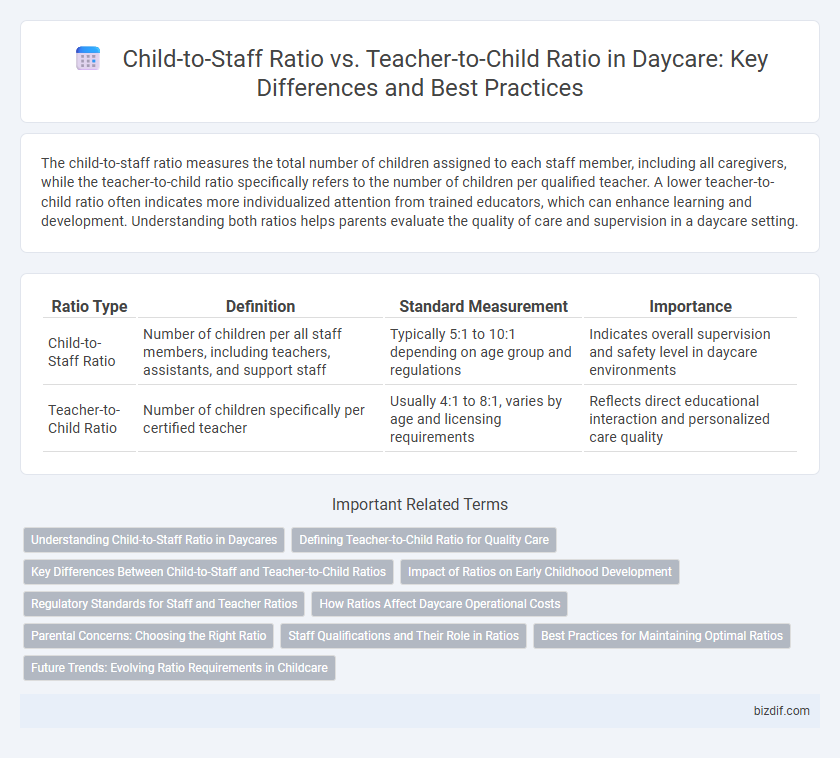The child-to-staff ratio measures the total number of children assigned to each staff member, including all caregivers, while the teacher-to-child ratio specifically refers to the number of children per qualified teacher. A lower teacher-to-child ratio often indicates more individualized attention from trained educators, which can enhance learning and development. Understanding both ratios helps parents evaluate the quality of care and supervision in a daycare setting.
Table of Comparison
| Ratio Type | Definition | Standard Measurement | Importance |
|---|---|---|---|
| Child-to-Staff Ratio | Number of children per all staff members, including teachers, assistants, and support staff | Typically 5:1 to 10:1 depending on age group and regulations | Indicates overall supervision and safety level in daycare environments |
| Teacher-to-Child Ratio | Number of children specifically per certified teacher | Usually 4:1 to 8:1, varies by age and licensing requirements | Reflects direct educational interaction and personalized care quality |
Understanding Child-to-Staff Ratio in Daycares
Child-to-staff ratio in daycares represents the total number of children per adult staff member, encompassing both teaching and support personnel, which ensures overall safety and supervision. Teacher-to-child ratio specifically measures the number of children per certified teacher, highlighting the quality of educational interaction and individualized attention. Understanding the distinction between these ratios helps parents evaluate daycare environments for balanced care and effective learning outcomes.
Defining Teacher-to-Child Ratio for Quality Care
Teacher-to-child ratio refers to the number of children assigned to each teacher or caregiver within a daycare setting, directly impacting the quality of supervision and individualized attention. Lower ratios ensure that educators can effectively manage safety, support developmental needs, and engage children through personalized interactions. Regulatory standards often specify maximum teacher-to-child ratios to maintain optimal care environments and promote positive developmental outcomes.
Key Differences Between Child-to-Staff and Teacher-to-Child Ratios
Child-to-staff ratio measures the total number of children per all staff members, including aides and support personnel, whereas teacher-to-child ratio specifically counts only certified teachers relative to the number of children. This distinction impacts regulatory compliance and quality standards because teacher-to-child ratios directly influence educational interactions, while child-to-staff ratios reflect overall supervision and safety. Understanding these key differences helps daycare centers allocate resources effectively and meet licensing requirements for both child development and care environments.
Impact of Ratios on Early Childhood Development
Lower child-to-staff ratios in daycare settings promote individualized attention and enhance early childhood development by fostering social, cognitive, and emotional growth. Optimal teacher-to-child ratios ensure that educators can effectively respond to each child's needs, supporting language acquisition and self-regulation skills. Research indicates that reducing group sizes improves developmental outcomes and classroom quality, emphasizing the critical role of staffing ratios in early education environments.
Regulatory Standards for Staff and Teacher Ratios
Regulatory standards for daycare facilities emphasize strict child-to-staff ratios to ensure safety and individualized attention, typically mandating one staff member for every 4 to 10 children depending on age groups. Teacher-to-child ratios, a subset focusing specifically on qualified educators, require lower numbers, such as one teacher per 8 toddlers, to maintain effective learning environments. Compliance with these mandated ratios is monitored by state licensing agencies to uphold quality care and education standards.
How Ratios Affect Daycare Operational Costs
Lower child-to-staff ratios require hiring more caregivers, significantly increasing personnel expenses, which comprise the largest portion of daycare operational costs. Maintaining optimal teacher-to-child ratios ensures high-quality supervision and individualized attention but demands higher wages and benefits, driving overall costs upward. Efficiently balancing ratios is crucial for daycare centers to manage budgets without compromising safety and educational standards.
Parental Concerns: Choosing the Right Ratio
Parents prioritize a low child-to-staff ratio to ensure personalized attention and safety in daycare settings. Teacher-to-child ratios directly impact developmental support and effective supervision, influencing parents' choice of quality care. Understanding these ratios helps parents confidently select facilities that meet their child's individual needs for growth and security.
Staff Qualifications and Their Role in Ratios
Child-to-staff ratio measures the total number of children assigned per staff member, encompassing all personnel, while teacher-to-child ratio specifically counts certified teachers per child, emphasizing educational quality. Staff qualifications directly impact these ratios, as highly trained teachers provide specialized learning, and qualified support staff ensure safety and developmental care. Lower ratios with skilled educators correlate with improved child outcomes, highlighting the critical role of staff credentials in daycare settings.
Best Practices for Maintaining Optimal Ratios
Maintaining optimal child-to-staff and teacher-to-child ratios is critical for ensuring safety, personalized attention, and effective learning in daycare settings. Best practices include adhering to state regulations, regularly assessing children's developmental needs, and employing sufficient qualified staff to minimize group sizes. Implementing flexible staffing models and ongoing training programs supports maintaining these ratios consistently, promoting a nurturing and well-managed environment.
Future Trends: Evolving Ratio Requirements in Childcare
Future trends in daycare emphasize evolving child-to-staff ratio requirements to enhance individualized care and safety. Research indicates optimal teacher-to-child ratios improve developmental outcomes and regulatory bodies are moving towards stricter standards. Innovations in technology and data analytics enable real-time monitoring, supporting compliance with increasingly precise staffing ratios tailored to age groups.
Child-to-staff ratio vs Teacher-to-child ratio Infographic

 bizdif.com
bizdif.com